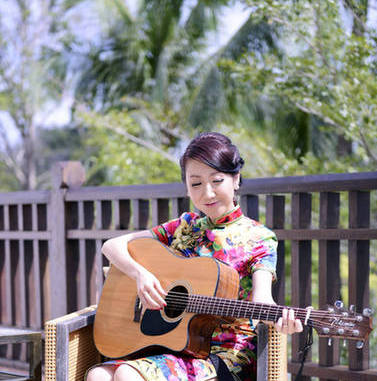Wang Tian: The Colorful World of Autistic Children
By staff reporter ZHOU LIN
WANG Tian’s studio is tucked in a densely shaded section of Beijing’s 798 Art District. Paintings featuring flamboyant colors and impressionist composition grab attention from passersby, but even more arresting is the sign bearing the facility name: “Autistic or Artistic? Art.” This question is raised to the public by studio owner Wang Tian – can children with autism be cultivated into artists? Her answer is a resounding “yes.”
“I hope that by bringing art to the hearts of autistic children, we can help them discover themselves and live a happier life,” said Ms. Wang.
Autism is a neural development disorder characterized by impaired communication and social interaction and restricted, repetitive behavior. Autistic children are thoroughly lost in their own world and barely respond to what’s around them. Many of them, however, are inherently gifted. Some liken such children to lone stars in the universe, far from each other but twinkling beautifully.
Wang’s first contact with autistic children came via teaching art classes to a child with the disorder while Wang was in high school. She later majored in special education at Beijing Normal University, and went on to study art therapy and NGO management in Paris. Upon returning to China in 2011, she co-founded the AoAart Studio, taking charge of its international affairs and giving art therapy classes.
 |
| Wang Tian. |
Qing Qing, a six-year-old girl in her class, has a communication handicap and displays some behaviors that can be incomprehensible to others. For example, she bends over to peer at every manhole she passes on the road. After considerable observation, Wang Tian realized that the girl did so to listen for water flow. She would also stop at any source of water. The sound pleases her. Wang then told the girl: “I love clouds and swallows. The sight of them pleases me as much as the sound of water for you.” Days later Qing Qing presented her a painting of swallow gliding through white clouds, which brought Wang to the verge of tears. The overwhelmed teacher wrote a song to Qing Qing titled “Your Existence.”
“It’s hard to melt the thick coat of ice blocking autistic children’s hearts and get into their inner world. Wang’s art therapy works in this aspect,” remarked colleague Yang Di. The studio offers three art courses for autistic children, one for therapy, one as a hobby and one to cultivate professional skills. Every class is modified to cater to the specific conditions and needs of individual kids to get them as involved as possible interacting with the teacher and other students. The purpose is to stimulate autistic children’s curiosity so much that they open up to the outside world, and to help them learn to make effective, lucid expressions.
Wang Tian and her colleagues believe that art can enhance autistic children’s prospects of achieving financial independence in adulthood. “Children who have shown artistic talent are tutored to create paintings, which will be put up for sale at galleries cooperating with the studio,” explained Wang. “We also have an agreement with shopping website Taobao.com, through which our students’ paintings will be developed into derivative products by art agencies.”
Such derivative products are displayed at the studio, ranging from T-shirts, mugs and postcards to key rings. Wang particularly likes a green silk shawl with vermilion fox prints, which was gleaned from a child’s drawing. “This is my favorite,” she said. “These young artists’ creations are pioneering in terms of color selection – highly impressionistic and imaginative. These are all fashionable qualities.”
To increase public awareness about autistic children, AoAart Studio is cooperating with a foundation to participate in a charity program called “Support Without Language” initiated in London. The program invites autistic children from different countries to create massive paintings – 1.5 x 4 meters – to be displayed at landmark buildings in major cities around the world. With sponsorship from the University of the Arts London and other British institutions, the first installment of the program has already been carried out successfully in London.
“Art is a bridge connecting individual hearts,” Wang declared. “It allows me to enter the rich inner world of autistic children. I hope that art can also empower these kids to reach the outside world and live a richer life.”

